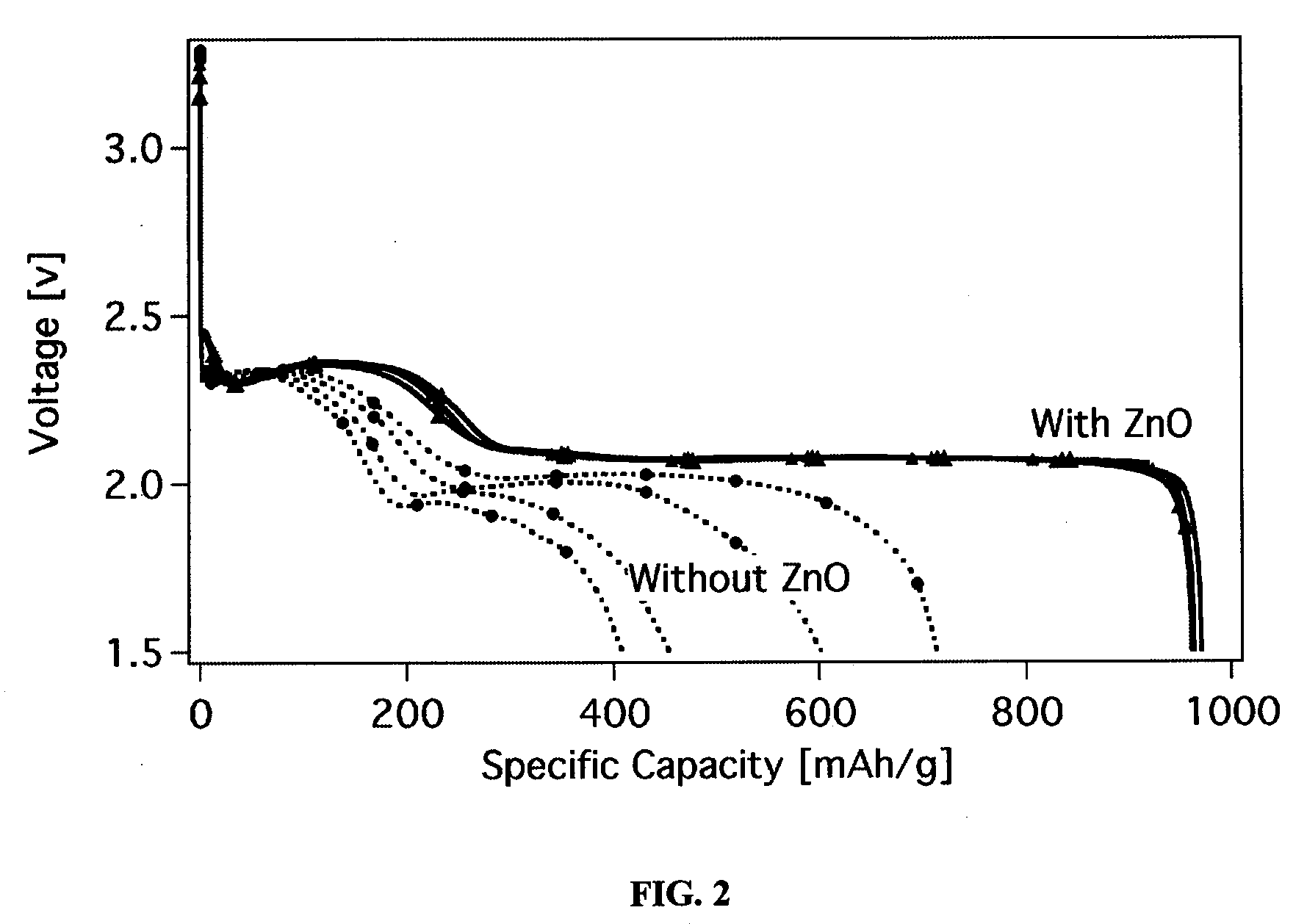[0008]The present invention provides an improved lithium-sulfur battery, a cathode for a lithium-sulfur battery, and methods of forming the cathode and battery. The ways in which the present invention addresses the drawbacks of prior-art batteries will be discussed in greater detail below. In general, the batteries of the present invention exhibit increased
energy density and
specific energy, compared to traditional lithium-sulfur batteries. In addition, the batteries are relatively safe and affordable, compared to other battery technologies.
[0009]In accordance with various embodiments of the invention, a battery includes an anode containing lithium, a cathode containing sulfur and a
metal oxide, a separator, and an
electrolyte. As explained in greater detail below, the metal oxide serves to improve the performance of the battery by holding polysulfides within the cathode structure. As a result, the cathode
discharge efficiency increases and the lithium-sulfur
cell delivers longer service life. In addition, an amount of polysulfides that might otherwise migrate to the anode and passivate the anode is expected to be significantly reduced. In general, the metal oxides are selected from materials that are generally compatible with materials typically used in the manufacture of batteries. In accordance with various aspects of these embodiments, the metal of the metal oxide is selected from Group I and
Group II metals, for example, metals capable of a +2 or +3 valence state. Suitable exemplary metal oxides include: CuO, Bi2O3, SnO, ZnO, and Mn2O3. In accordance with additional aspects of these embodiments, the cathode further includes a polymeric material to further reduce the
diffusion of polysulfides towards the anode. The use of metal oxide and / or the
polymer as a cathode additive improves the
discharge performance of lithium-sulfur cells. In accordance with additional aspects of these embodiments, a lithium-sulfur
cell further includes a separator containing an inorganic additive as means to further mitigate or prevent polysulfides from migrating towards the lithium anode. The separator can be made from, for example, polymers such as
polyvinylidene fluoride (PVDF),
polyvinylidene fluoride-co-
hexafluoropropylene (PVDF-HFP),
polyethylene (PE),
polypropylene (PP), or similar polymers and inorganic additives such as clays or organically modified clays (e.g., clays including cationically or anionically or chemically modified surface functional group(s)).
[0010]In accordance with additional embodiments of the invention, a battery includes an anode containing lithium, a cathode containing sulfur, an
electrolyte, and a separator, including a
polymer and inorganic additives such as clays or organically modified clays. In accordance with various aspects of these embodiments, the cathode includes a metal oxide selected from materials that are generally compatible with materials typically used in the manufacture of batteries, including Group I and
Group II metals, such as metals capable of a +2 or +3 valence state. Suitable exemplary metal oxides include: CuO, Bi2O3, SnO, ZnO, and Mn2O3. In accordance with additional aspects of these embodiments, the cathode further includes a polymeric material to further reduce the
diffusion of polysulfides towards the anode.
[0011]In accordance with further exemplary embodiments of the invention, a battery includes an anode containing lithium, a cathode containing sulfur, and an electrolyte physically separated from the electrodes by a barrier. The barrier is ruptured or otherwise broken prior to battery use to allow the electrolyte to contact the electrodes. Use of such a barrier increases the storage life of the battery. In accordance with various aspects of these embodiments, the cathode further includes a metal oxide, such as those described herein. In accordance with yet additional aspects, the cathode includes a polymeric material, such as
polyamide materials. And, in accordance with yet further aspects, the battery further includes a separator, including inorganic fillers such as clay or organically modified clay.
[0013]In accordance with yet additional embodiments of the invention, a cathode for use in lithium-sulfur batteries includes sulfur and a separator, including inorganic additives, such as clays or organically modified clays. In accordance with various aspects of these embodiments, the cathode further includes a metal oxide selected from materials that are generally compatible with materials typically used in the manufacture of batteries, including Group I and
Group II metals, such as metals capable of a +2 or +3 valence state. Suitable exemplary metal oxides include: CuO, Bi2O3, SnO, ZnO, and Mn2O3. In accordance with additional aspects of these embodiments, the cathode further includes a polymeric material, such as
polyamide material, to further reduce the diffusion of polysulfides towards the anode.
 Login to View More
Login to View More  Login to View More
Login to View More 


